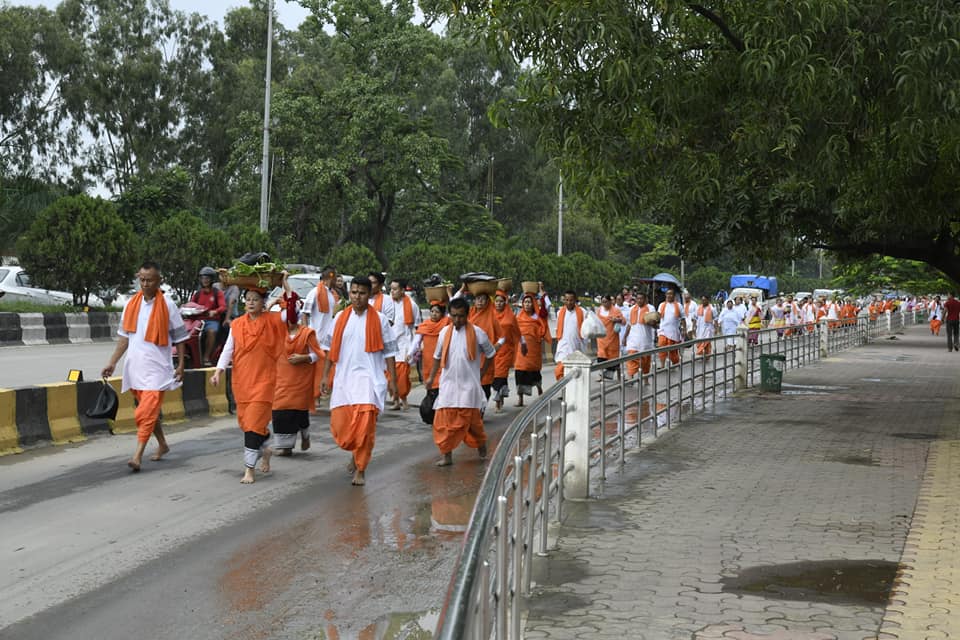The Lai people worships Sanamahi. These people have descended from the Koubru mountains. And settled in different hills and plains of Manipur and divided into seven salai.
The seven sons of Ipudhou Konchin Tukthaba Pakhangba, viz., Mangang, Luwang, Khuman, Angom, Moirang, Kha Nganba, Salai Leishangthem ruled in Meetei Leibak.
Mangang was given the Imphal Kangla to rule independently; Luwang was kept at Luwangsangbam kangla; Khuman was given the Nongyai Leikoipung (present day Mayang Imphal).
Angom was given the Kongba Maru Kangla; Moirang salai was given the Moirang Kangla; Kha Nganba was given the Kha Nganba Taknakha Puruk Soubi kangla and Salai Leishanthem was given the Leishangkhong Kangla.
Konchin Tukthaba Ibudhou Pakhangba made his eldest son, Mangang king as the pibarel Ningthou and his other six sons as the Piba Ningthou. However, some historians are deliberately making the Mangang Salai as Meetei and other Salai as tribes which were amalgamated into Meetei in due course. This is to confuse the younger generations that Meetei are divided people formed by different communities.
When the population was increased, these offspring of Konchin Tukthaba Ibudhou Pakhangba started looking for more habitable lands in the plains and hills of Meetei Leibak. Many of the Meetei who were migrated to the hills were adopted by Seloi Leima (wife of Salailen Sidaba). They have different languages, cultures and costumes in their evolutions.
Meeteis who migrated to the Koubru Laiji were known as Meetei Kabui. They were further migrated towards present day Nagaland, known as Liyangmei, Zemei, Longmei, Poumai, Aomei, Lothamei, Angamei etc. Similarly, we have Meetei Kom, Meetei Maring, Meetei Tangkhul. All these tribes have seven salais.
Meetei Kabuis believes in a multiple of Gods and Goddesses, local deities and spirits and also in a Supreme God, Ra-Gang (King of Gods) whose abode is in Heaven and who is immortal and eternal. They have got their Maiba (whom they call Molls).
The Meetei Koms believe in spirits and other natural forces and also in ancestor worship. Meetei Thadous also believe in the concept of heaven and hell. They have also the deity of the house called Indoi (like Lainingthou Sanamahi).
The Kom tribes have also Iuroi ,a household god. They also believe Pathien(Supreme God), and his brother Lungiei. The Vaiphei tribes also believe in Pathein and Indoi as the guardian spirit of every household, besides the various spirits who are equally worshiped and feared.
The Meetei Chothe since time immemorial believe that they are the descendants of Pu Lungchungpa or Pu Pakhangpa the mythical Dragon-Python God as their Supreme Principal Guardian God.
They also believed in the cosmic Heavenly and Earthly Gods -Thangvan rengpa and Shimlei rengnu. They considered that Pu Pakhangpa is the divine incarnate of Pu Lungchungpa and therefore revered and worshipped Him.
Several British political Agents like McCulloch, TC Hodson, Shakespeare and other scholars have stated in their ethnographies and books that the Chothe tribes worship several gods like Lungchungpa, Pakhangpa, Soraren, Sanamahi, Leima, Chungpathin and Tuipathin Among the above deities Thangvan rengpa or Soraren have been treated as Heavenly God, while Pu Lungchungpa or Pakhangpa as God on earth.
The Meetei Tangkhul believes in a supreme Lord which is Atingkok Salailen Sidaba who rules the universe. He is the male god whose name is held in deepest reverence, and who lives in heaven.
He is multifaceted and accordingly has various names such as “Kazing Ngalei Kasa Akhava” meaning “The Master and Creator of heaven and earth”, “Varivara” meaning “Cradle of Peace”, “Kazingpa” meaning “the one who dwells in heaven/dweller of heaven”, etc.
There is considerable evidence that the worship of Lainingthou Sanamahi spread from the Meeteis to the Kukis and Tangkhuls and the Purum tribes in the Hills of Meetei Leibak. Sanamahi had a place in the Luira festival of the Tangkhul Tribes which takes place just before the sowing of crops.
On the third day of the festival, the head of each household or the family head offer prayers to the domestic God Sanamahi for the bountiful harvest.
In every Purum tribes, Sanamahi is a House God. Sanamahi occupies a particular place in the house and is worshipped to obtain health and prosperity.
The Meetei Marings also believed that there is one God. He is the Creator (Seempi-ShapiPu) of all things, including heavens (thangwan, nungthou, khiya ram) and human beings and things; the Sustainer (Dunpi-yukpiPu), the God of Universe (Shimlei-ThangwanPu).
Besides this, they also worshipped the local deity called Rampu-tupu or ram thrai or lukbamthrai (god of the sacred places); they also believed in the village deity (Kholamal-pu or pallshungthrai); and the ‘ancestral deity’ called Cheem-thrai.
Lainingthou Sanamahi is a Meeteilon word and could not have originated outside Meetei Leibak. Sanamahi is a Salai deity and every tribes having yek salai are associated with Sanamahism.
The religion of the Lai people is spread through the whole of Meetei realms now. In fact, lai people living across the South East Asian countries worship local deities.
In Thailand, Lai people worships Sanamahi type of God. Their temple and rituals are somewhat similar to the Meetei. We have to find out more about them.
In fact Lai people worships Sanamahi shows that Meetei civilization is vast and one of the oldest in human evolution.
(C) Naorem Mohen
The Writer can be reached at Twitter @laimacha
Editor | Signpost News







Comment on “Do You Know Lai People Worships Sanamahi”